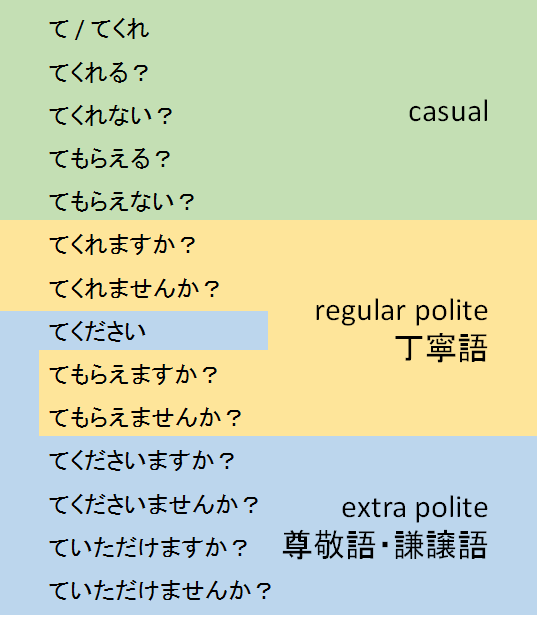Oo. Challenge accepted! I’ll try my best to answer these, but others (@mrnoone @Jake) might be better qualified to give a precise answer.
くださる is the 尊敬語 honorific polite version of くれる. So when you say 話してください, you’re saying “[please] speak for me” in an honorific way. The way that Japanese is typically taught to English speakers, they usually just give a quick explanation that it’s a polite request or that you should just memorize it, but it actually has its root in humble keigo. Now, of course, it’s used so commonly that it doesn’t have as strong an impact as 話していただけませんか? and technically you’re politely “commanding” rather than “requesting” so it’s not quite as polite.
警護:丁寧語 — regular polite language, no extra meaning, usually used before you know your relative position to your listener or just to be “neutrally” polite.
警護:尊敬語 — honorific polite, raises the listener above you, shows that you respect the listener
警護:謙譲語 — humble polite, lowers the speaker or the speaker’s in-group 内 below the listener, shows that you are not as important as the listener
I’m speaking specifically here about the verb form and vocabulary. Using the ます form is regular 丁寧語 polite . Honorific 尊敬語 and humble 謙譲語 use different vocabulary.
行きます — to go, regular polite
いらっしゃいます — to go, honorific polite
まいります — to go, humble polite
(Some train stations will announce 電車がまいります because they’re being humble about themselves to their customers.)
So, with business settings or formal gatherings, honorific and humble keigo (尊敬語 and 謙譲語) is just standard, just as you would hear “ladies and gentlemen” at gatherings that carry some formality.
And at restaurants and such, honorific/humble keigo is used as a standard but often the staff (especially younger staff) use the words as part of set phrases and immediately switch to regular polite when you ask questions to them. Restaurants are “serving” the customers and therefore have a lower status than the customer.
So both of your examples can use honorific/humble keigo. Yuta is being extra polite because his role as interviewer carries a different [lower] status than if he talked to someone without a microphone.
(I started typing a whole lot more but I realized that I was writing a novel, because there’s so much to explain that’s different from Western culture, so I shortened it and hopefully this is enough to get a foundation.  )
)
I use these words:
タメ語 — casual language (タメ means “between peers”)
失礼な言語 (しつれいなげんご)— rude language
下品な言語 (げひんなげんご)— vulgar language
I’d love to hear suggestions from others.
Otherwise, I think the assumption from native Japanese is that casual is the baseline and anything else is a conscious effort, so they point out 丁寧語 / 尊敬語 / 謙譲語 but don’t point out casual language.
(Btw, I also think they’re used to foreigners speaking a weird, unnaturally polite form of Japanese, so don’t get stuck on any of this.  )
)
[Edit: 丁寧語 is a subset of 警護, but I didn’t learn it that way. I fixed my explanation to be more correct.]
[Edit: 下さる is honorific form of くれる]

![To give and to receive in Japanese: learn ageru/kureru/morau (あげる・くれる・もらう) [JLPT N5]](https://i.ytimg.com/vi/MKJkNULgizw/maxresdefault.jpg)


 ).
).